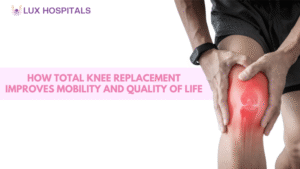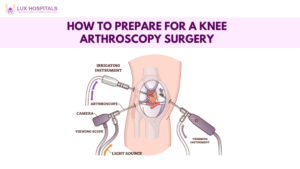Knee Replacement Surgery: Types, Procedure, and Recovery

Knee replacement surgery is a highly effective treatment option for individuals experiencing severe knee pain, stiffness, and reduced mobility resulting from arthritis, injury, or other conditions. It involves replacing damaged parts of the knee joint with artificial implants to restore function and minimize discomfort. With advancements in medical technology, knee replacement surgery has become safer and more precise, and offers quicker recovery times. This article will explain the types of knee replacement operations, the actual procedure, and the recuperation period to help patients make informed decisions.
Types of Knee Replacement Surgery
Different types of knee replacement surgery are performed depending on the severity of the damage and the patient’s health condition.
- Total knee Replacement: The most popular kind is total knee replacement (TKR), in which the entire knee joint is swapped out for a new one. It is recommended for patients with widespread arthritis or joint damage.
- Partial Knee Replacement (PKR): In this type, healthy bone and tissue are preserved because only the injured knee is replaced. It is appropriate for people who have only one type of injury. side of the knee.
- Revision Knee Replacement : The treatment known as knee replacement is carried out when an earlier knee replacement surgery fails or wears out over time, necessitating the correction or replacement of implants.
- Minimally Invasive Knee Replacement: A modern approach using smaller incisions and advanced tools for faster healing and reduced pain.
These types of knee replacement surgery ensure personalized treatment for patients, improving long-term joint function and mobility.
Procedure of Knee Replacement Surgery
The knee replacement surgery procedure typically takes 1–2 hours and involves several steps:
- Preparation and Anesthesia: The patient is administered either general or spinal anesthesia to ensure their comfort.
- Incision: To gain access to the knee joint, a small incision is made over it.
- Reshaping the Knee: Damaged bone and cartilage are carefully removed and replaced.
- Implant Placement: Artificial implants made of metal, plastic, or ceramic are fitted into the reshaped joint.
- Closure: The incision is closed with sutures, and the knee is wrapped in a bandage.
Surgeons use advanced imaging and navigation techniques to ensure precision during knee replacement surgery, resulting in better alignment and function.
Recovery After Knee Replacement Surgery
Following knee replacement surgery, recovery is a gradual process; however, with proper care, most patients experience a significant improvement in mobility.
- Hospital Stay: Patients usually stay in the hospital for 2–4 days, depending on the type of surgery performed.
- Physical Therapy: Rehabilitation begins soon after surgery, focusing on improving strength, flexibility, and mobility.
- Pain management: is aided by cold therapy and medications. discomfort during the early stages of recovery.
- Return to Activities: Most patients resume light activities within six weeks and can return to their regular daily routines in three to six months.
A successful recovery depends on following medical advice, attending physiotherapy sessions, and maintaining a healthy lifestyle. Following knee replacement surgery, patients frequently have improved quality of life and regain their independence.
Benefits of Knee Replacement Surgery
Knee replacement surgery provides several benefits, including:
- Long-term pain relief from arthritis and joint degeneration.
- Improved knee movement and mobility.
- Higher success rate with advanced surgical techniques.
- Enhanced ability to perform daily activities without discomfort.
These benefits make knee replacement surgery one of the most common and effective orthopedic procedures worldwide.
Lifestyle Changes After Knee Replacement Surgery
After knee replacement surgery, adjusting to daily life calls for perseverance and good habits. Patients are urged to:
- Maintain an active lifestyle with low-impact exercises, such as swimming or cycling.
- Avoid high-impact sports that put pressure on the new knee joint.
- Eat a balanced diet to support healing and bone health.
With these lifestyle changes, patients can extend the life of their implants and continue enjoying pain-free movement.
Conclusion
A life-altering operation, knee replacement surgery relieves persistent knee pain, increases range of motion, and regains freedom. Patients can receive individualized therapy that is catered to their unique needs with alternatives like minimally invasive, partial, and total methods. Implants can survive for decades with appropriate healing and lifestyle modifications, and the procedure has a high success rate. Knee replacement surgery gives people with knee issues the opportunity to live an active, pain-free life.
Frequently Asked Questions
Depending on the patient's health and level of physical therapy commitment, recovery from knee replacement surgery usually takes three to six months. Within a few weeks, some people see a discernible improvement, while others can take longer.
During the procedure, patients are under anesthesia and do not feel pain. After knee replacement surgery, mild to moderate discomfort is expected but can be managed with pain medications and therapy.
Modern implants used in knee replacement surgery can endure for 15–20 years or more with the right maintenance. Longevity depends on an individual's activity level, overall health, and the type of implant.
Yes, patients can climb stairs after knee replacement surgery, but it may take a few weeks to do so comfortably. Physical therapy exercises help strengthen the muscles needed for climbing. Gradual practice ensures safe movement.
There is no fixed age, but the majority of knee replacement surgery patients are in the 50–80 age range. Younger patients with severe injuries or arthritis may also be eligible. The degree of joint injury determines the decision, not just age.




















